Podcast: Seraphim's Soliloquies Episode One (Life)
Movement, objects, speech, and words: We communicate through gross symbols. We call them 'objective', but we cannot escape our point of view...
What is a lifetime?
We bandy the word ‘life’ around without a care to its true meaning…
Is life simply the period from birth till death?
Is it ones achievements, ones failures?
Is it the memory left behind when the ashes cool, or the corpse rots?
What is a good life?
Or a bad one for that matter?
How does one measure a life?
Do we weigh it like an angel at the gates of heaven, or chart its length and breadth?
Does such indicate a life well lived?
Maybe it’s just a profile of likes within binary code?
Is life subjective, does it differ depending on the observer, or is it fixed?
Do we really all live separate lives, or is there a template to which we conform?
How is it consumed, wasted, lost, struggled through, and yet lived?
Does life have any true value?
Does it matter?
Why is it so important?
These, and many other questions came to mind when writing ‘A Lifetime of Planetary Cycles’.
And although that story was never intended to answer them (it's purpose was to highlight the design, and order inherent in our life - all life). These questions remain, hanging in the air like the notes of a familiar tune…
One of the central tenants of the wisdom of the Buddha (as expounded in the ‘Tibetan Book of the Dead’ and ‘Tibetan Book of Living and Dying’), is that we can (and should) use our lives to prepare for death.
The planets show us that this is true, for all things (including planets and stars) live, and ultimately die some day.
The addendum that follows highlights how the final Planetary influences within (hu)man, towards the end of a life, do just that…
Death is the only thing life can be said to be truly working towards.
The following quote, taken from the afore mentioned: ‘Tibetan Book of Living and Dying’, p24*, sums up quite succinctly the essence of the influence of the planets within us all:
“I realized that there are things that every person is sent to earth to realized and to learn. For instance, to share more love, to be more loving towards one another. To discover that the most important thing is human relationships and love and not materialistic things. And to realize that every single thing that you do in your life is recorded and that even though you pass it by not thinking at the time, it always comes up later”.
Is this then what our life is.
A preparation for death, and life anew.
A test, a task, a training ground for the next time around the wheel…
The time of our birth mapped out in the starry sky is the guide to our lives, and what we need to learn, overcome, accept, and cast aside in preparation for death (and rebirth).
For that is the pattern and design of the cosmos, and that it the wit on (hu)man…
* Believed to be taken from Kenneth Ring’s book: ‘Heading Towards Omega: In search of the Meaning of the Near-Death Experience’, published by Quill, 1985.
Talking of patterns and designs.
Any discussion of life cannot be fully understood without knowledge of the ‘sacred’ geometry within (and without).
It has been mentioned more than once in the stories shared, this logarithmic phenomenon known as the golden ratio.
The golden ratio (often represented by the Greek letter φ) is directly tied to the numerical pattern known as the Fibonacci sequence - a list composed of numbers that are the sum of the previous two numbers in the sequence.
It is often referred to as the natural numbering system of the cosmos.
When this golden ratio is applied, you get a type of logarithmic spiral known as a golden spiral, which can be found throughout nature (including within (hu)man).
Throughout the stories to come we will often be referring to this geometry, and as such (because an image speaks a thousand words), what follows is a graphical representation (to add some meaning):
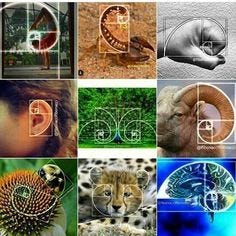
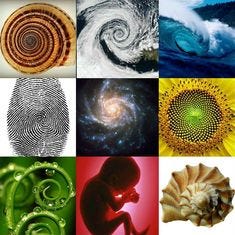
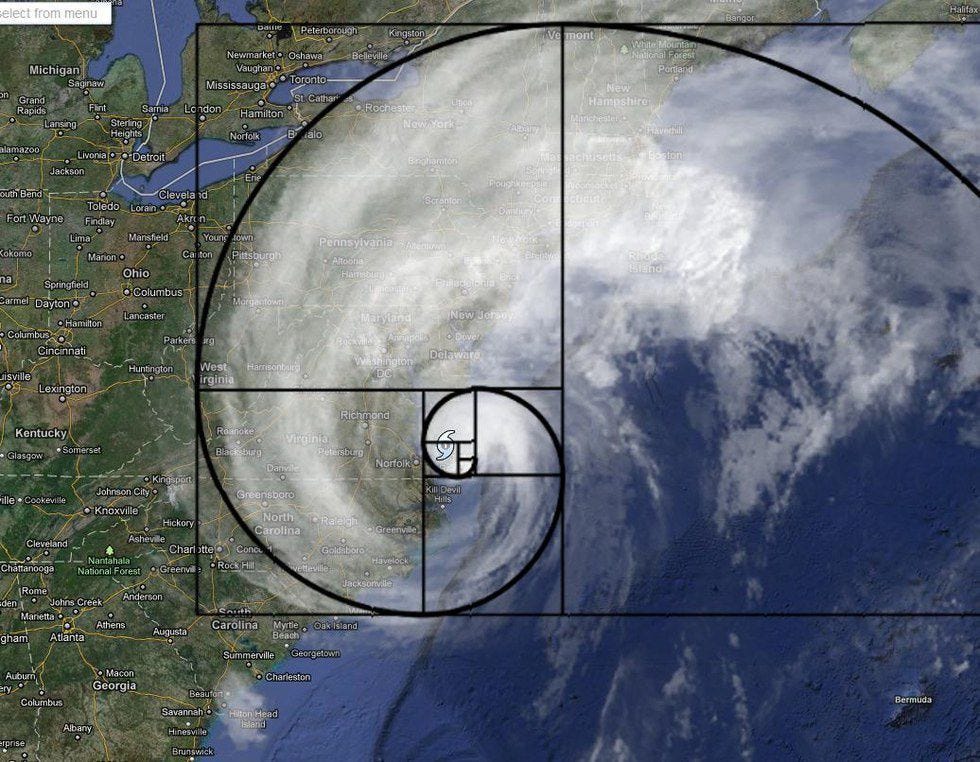

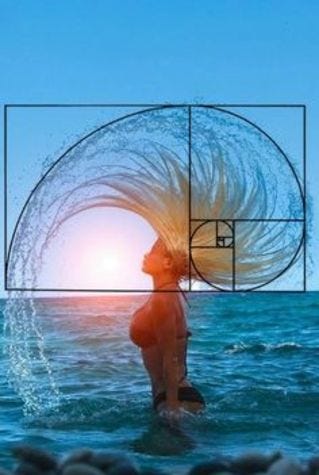
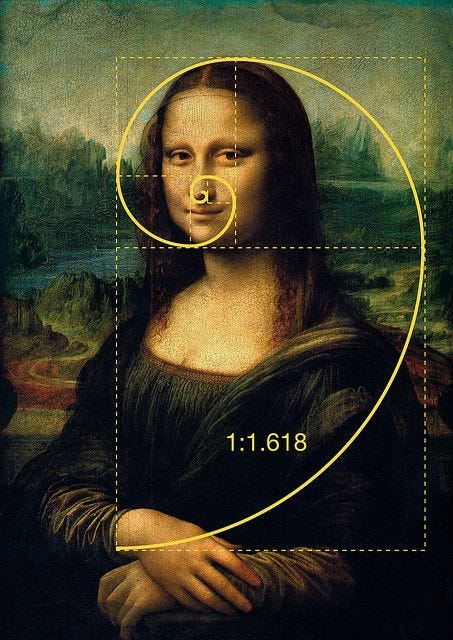
Once you know what to look for, you will start noticing this Golden Ratio everywhere.
Just look at your hands…
Even our fingers (and wider skeletal system) follow the Golden Ratio.
(Hu)man’s eye is used to seeing this magical number (everywhere across Earth) and we subconsciously react positively to it…
All life on Earth follows these assigned patterns within a grand design, and knowledge and acceptance of this is essential for the conscious understanding of (hu)man’s place, and role, within this ‘thing’ we term a life.

When writing the first story for the launch of Sacred Sequencing, it became apparent that there is never enough space (or time) to cover everything that is required…
At the start of ‘A Lifetime of Planetary Cycles’ was mentioned the ‘Ages of Man’, however the story never adequately closed the circle, by returning to Ptolemy’s observation (after having expounded on each of the individual planetary influences).
The penultimate paragraph:
“... We have the following map to our lives: 0, 2, 4, 6, 7, 8, 10, 11/12, 14, 16, 18, 20, 21, 22, 23/24, 26, 27/28, 29.5, 30, 32, 34, 35/36, 38, 40, 41/42, 44, 45, 46, 47/48, 49, 50, 52, 54/55, 56, 58, 59/60, 62, 63, 64, 66, 68, 70, 71/72, 74, 76, 77, 78, 80, 81/82, 82/83, 83/84, 86, 88, 88.5, and 90 (A surprising amount of a life)”.
Failed to properly expound on the practical meaning of such.
What follows is an addendum, detailing these stages (informed by the contents of that story), in order to provide greater clarity of how those cycles unfold in our lives (conforming, by and large, with the words of Ptolemy and Shakespeare):
Our Childhood
From (hu)man’s birth until the beginning of our teenage years we are governed primarily by the cycles of Venus, Mercury, and the Moon.
(Hu)man experiences their first Venus rose cycle at the age of eight, as well as the regular cycles of the moon and mercury, but there is no direct impact from the other planets on (hu)man until we go into puberty.
Therefore, confirming (to a degree) the first stages of what Ptolemy expounded – that the moon (primarily) rules the pliable infant and toddler from birth till the age of three, and mercury rules the young child up to the age of 13.
Our Teenage years
Between the ages of 12 and 15 (hu)man starts to feel/experience the influences of the other planets.
Firstly, Saturn has reached the halfway point of its first cycle (as does the progressed Moon cycle), and Jupiter completes its first full cycle between the ages of 11 and 12.
At the age of 14, Uranus makes its second (stronger than the first at age seven) aspect to its birth position.
Neptune also makes its first contact with itself (its first 30-degree aspect aligned as these are with Uranus).
This is our first important milestone point – the start of our adolescence!
For the first time, (hu)man is tasked with making decisions for ourselves.
And the decisions we make during adolescence can (and often do) profoundly influence/shape what happens during the rest of our lives.
Uranus pulls (hu)man out of the state of childhood with the onset of puberty and the awakening of sexual awareness.
Meanwhile, Saturn increases the inevitable sense of duty as we are expected to assume much more responsibility, and we start to contribute to our community (whether that is simply as part of our family - because we are not a child anymore, or within the wider community).
We are usually expected to work for pocket money at this stage in life (setting the stage for enforced wage slavery at a relatively early age).
Jupiter, now starting its second cycle, takes (hu)man’s growth and learning one step higher as we attend high school, and a few years later, halfway through Jupiter’s cycle, we then go on to university or our first proper job(s).
Ptolemy states that Venus rules the pubescent young adult from 14 to 21, which commences two years short of two eight-year Venus rose cycles, although we do complete our second such cycle during our lives at the age of 16, so maybe this is the rationale for assigning this period to Venus?
This association however is a little unclear.
Our early Adulthood
At the age of 21, both Uranus and Saturn make hard aspects to themselves, as does the progressed Moon.
However, Jupiter does not make any important aspects at this point in our lives, as such the feeling of Growth is not necessarily there to soften the blows of this turning point.
Suddenly, we find ourselves no longer teenage adolescents, but adults.
At 21 (hu)man often realises that the dependence on our parents cannot be guaranteed anymore (at least (hu)man used to, with some of the planets slowing down their transits over the past years (particularly Pluto) it seems that younger generations take a little while longer to reach the points in life that felt clearer, crisper in times gone by – most of my generation had long since left home by this stage, myself included, and we were working and raising families).
This change in (hu)man is due to Uranus taking the parental safety net away (if only on an emotional level), and Saturn starts pushing (hu)man into the outside world to fend for ourselves.
For the next seven years (up to the age of 28) (hu)man is still in a nascent stage, we leave the nest for periods of time but need to come back to it and our family, often for reassurance.
During our 20s, Neptune and Pluto both make important aspects to themselves (and each other), subtly awakening a spiritual need within (hu)man (and how we react to this shapes the spiritual path within us, and it determines when the kindling catches, and the spiritual fire starts to burn within).
The combination of Neptune and Pluto energies show (hu)man that there is more to life than just the physical, emotional and intellectual.
Failure to grasp this important observation at this age in life means that (hu)man has to wait until the next such Planetary aspect(s) in order for this combination to be activated in our lives.
On turning 30
Between the ages of 27 and 29, many of (hu)man’s comfort zones change.
Although it is not always in an obvious way, (hu)man’s life changes forever as any residual remnants from our childhood are finally left behind.
This is the effect of the Saturn return (between the age of 29-30), right on the heels of the progressed lunar return (ages 27-28) and is also a period of our lives that is preparing the way for the coming Jupiter return (ages 35–36).
During this period Uranus also trines itself (ages 28-29), so whatever happens to us at this point in life, can jolt us considerably, and this period of time is generally considered to be challenging one.
This is (hu)man’s first major crossroads and it represents the end of what has often been termed our ‘experiential’ cycle, and the start of what is termed our ‘productive’ cycle.
(Hu)man takes our place within the wider community and we (usually) start contributing by raising the next generation.
We are not only grown up, we have become ‘individuated’.
(Hu)man is now who we were/are meant to be, and what we have become as a result of the choices we have made up to this point in our lifecycle.
Consider this to be the conclusion of the first “Act” of (hu)man’s life, one that will be repeated twice more, with each turning point (conclusion) echoing the choices we made during these first 30 years of living.
(Hu)man now knows what to expect from life, and we can use this knowledge we have gained since birth, up to the age of 30 to make better choices the second, and third time around.
This fact becomes particularly apparent as (hu)man approaches the age of 40.
Ptolemy described this ‘prime’ of life period as being ruled by the Sun (from age 22 till 40), the only reasoning that can be discerned for this is that this period of our lives is where we truly become/are who we are, who we will be for the majority of our lives (who we were destined to become, as it was written at the time of our birth), and as the Sun represents the heart and soul of (hu)man, it is appropriate that the Sun should rule this period of (hu)man’s life up to the age of 40.
The peak of our life through the 40’s
40 is considered the peak of (hu)man’s life, and it is the stage we have been working towards since we were born.
For those born during the 1960s and early 1970s we started to feel these influences around the age of 35.
But, as Pluto is slowing down, those born after the mid-1970s now feel this closer to the age of 40 (and for some even beyond even this age).
In (hu)man’s early 40s, we have the biggest build-up of planetary aspects concentrated within a few years.
This combination of influences does not occur again until we hit our mid-80s.
Therefore, this period is both a turning point and a major crossroads within (hu)man’s life, and the path we choose now sets the tone for the rest of our life.
Uranus reaches the halfway point of its cycle at the age of 42.
This is a wakeup call and brings great change (and often destruction within our lives).
It is no coincidence that divorce rates are higher for this age group than any other.
This is the time that our children leave home, and it is also the time that a number of women begin menopause.
It is also often the time that (hu)man often make major changes in our career.
Saturn is also at the halfway point of its second cycle.
Together, Uranus and Saturn lead towards a letting go of some kind, whether it is within our lifestyle, a relationship or an ambition (this is inevitable, and affects every (hu)man).
(Hu)man is asked (by the planets) to consolidate what works for us (as individuals), and to build on that, rather than hanging on to any dead weight we may be carrying through life.
It is also at the age of 42 that Jupiter is at the halfway point of one of its cycles, as is the progressed Moon.
Even Neptune and Pluto are in on the act, as they form squares to their natal positions.
Furthermore, at the age of 45, according to the Solar Arc direction, every planet in our natal birth chart forms a hard aspect to itself, which triggers every single area of our lives.
This period of (hu)man’s life is finished off with a Jupiter return at 48, and the Chiron return at age 50 (Chiron was not included in the original analysis, but we will be returning to Chiron and the centaurs in the stories to come).
The common denominator during (what is commonly referred to as) (hu)man’s mid-life crisis, is the sudden awareness that we are mortal.
(Hu)man starts to truly realise that we will all die one day, that our time has limitations (and we start to perceive, and for some, fear our own mortality).
This realisation is brought on by Neptune and Pluto, and it is that realisation which creates the chain reaction just described.
Our 40’s is the time to realise our full potential as (hu)man. It is now that we set the tone for the second half of our life…
This is a “second chance”.
In order to handle our 40’s, (hu)man has to examine the important events of the past, and analyse how they relate back to the changes that occurred during the first Saturn cycle (because we are still carrying those choices and changes with us).
Ptolemy attributed the period of 41 to 55 as being ruled by Mars, and this is understandable as Mars is the voice of (hu)man, and embodies the ‘hero’.
It is during this period of our lives that (hu)man realise(s) their full potential, has a mini-breakdown because of such, and our ‘productive’ cycle is completed.
Our late 50’s
The end of this “productive” stage of (hu)man’s lifecycle occurs between the ages of 56 and 60 (dependent on the individual, and the manner in which the previous periods/lessons have been managed and internalised).
Once again, the planets make significant aspects to themselves, indicating yet another crossroads, but this time (by Solar Arc direction), every planet also makes positive aspects to their natal positions.
Therefore, unlike during the previous two crossroads points in (hu)man’s life, this is a time of opportunity.
(Hu)man has learned or experienced everything we need to become fulfilled.
This third cycle (starting now), is an “individualistic” cycle, where we are able to at last focus completely on ourselves.
This is the time to fulfil personal dreams and ambitions, write that book, travel the world, resurrect dreams that have been put on the backburner as we fulfilled all the necessary relationship and career commitments of the previous 60 years.
If we have learned from each of those previous turning points, this cycle is the most personally fulfilling of all, and is appropriately represented by Ptolemy as being ruled by Jupiter, the wise god of meaning from age 56 till 67 (when Saturn takes over rulership of the rest of our lives until death).
Our mid 70’s
At around the age of 74, there is once again another turning point (as if (hu)man hasn’t experienced enough of those during a lifetime).
This is one which echoes the previous “adolescent” turning point experienced at the age of 14.
Adjustments have to be made as (hu)man’s body is now starting to wear out…
(Hu)man starts to realise that we are no longer physically able to do many of the things we used to take for granted.
Our mind is no longer as sharp as it once was, and it now takes more effort to express the thoughts, and knowledge we know is locked in there.
Emotionally and spiritually, (hu)man becomes acutely conscious that we are now in the end phase of our life, and this is probably the most important lesson to be learned at this point in our lives - ‘acceptance’.
Finish that book/project, mend any broken relationships and, in general, tidy up your life in preparation for the final stage.
Our mid 80’s and the birth of a new reality
(Hu)man’s next/last turning point arrives between the ages of 84 and 90.
This period is the mid-life crisis all over again, only this time the planets are asking and guiding (hu)man towards choosing the path to our next incarnation.
Even if we choose to remain in this one for a little while longer (and fight against death), (hu)man’s thoughts, feelings, decisions, and actions all shape what comes next, not what is still here (clinging to life).
Neptune and Pluto once again play a major role during this period.
For the second and final time in our life Neptune will oppose itself, indicating a critical time in creating a new reality.
If you are reading this and are already over 60, you will know that when you get to this stage, Pluto for the first time in memory will oppose itself.
The age this happens will be later and later in life the younger you currently are.
But this planetary alignment of the planet furthest from us in the solar system indicates that final crisis, the moment (hu)man makes the final choice, the final choice that carries us through to death and beyond...

Still waiting for that natal chart reading....
ReplyDeleteLoki, I know and I'm sorry, I haven't forgotten. In the rare times that I go through someone else's chart I usually do it face to face so the owner can ask questions and I can highlight areas. It's not as easy trying to write it all down, and I will be honest with you I got a little distracted for a while. I will get it to you... I promise!
ReplyDelete